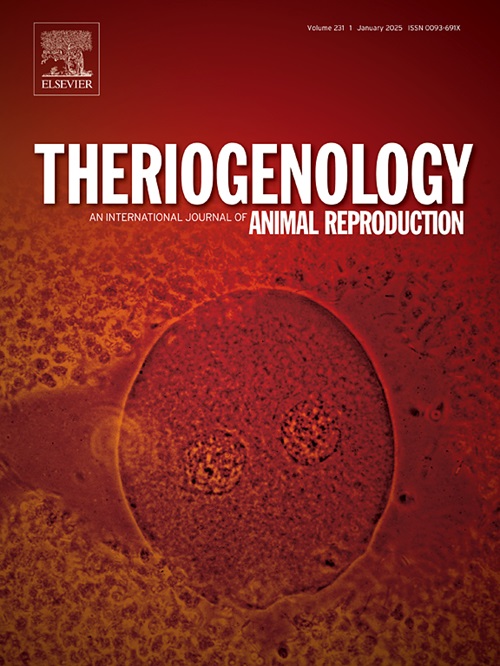血钙浓度及口服补钙对奶牛子宫健康有何影响?
IF 2.4
2区 农林科学
Q3 REPRODUCTIVE BIOLOGY
引用次数: 0
摘要
为了研究血钙(Ca)浓度对奶牛亚临床子宫内膜炎(SE)发生的影响,进行了一系列试验。试验1测定26头奶牛产犊后24 h血清钙水平,并与产后34 ~ 40 d SE发病率的相关性。产后24 h血钙浓度对多形核白细胞(PMN)计数有影响(P≤0.01)。在试验2中,选取47头回顾性分类为正常钙血症(Ca≥8.5 mg/dL)或低钙血症(Ca <8.5 mg/dL)的奶牛,随机分为产后6和30 h服用或不服用甲酸钙,并评估补充甲酸钙对SE发病率的影响。在产后34 ~ 40天,无论钙浓度如何,给予甲酸钙治疗均可降低PMN计数和SE发生率(P <;0.05)。血钙每增加1 mg/dL, SE发病率降低22%。试验3选用5头经产荷斯坦奶牛,采用2x2交叉模型,分为正常血钙血症组(Control)和诱导亚临床低钙血症组(iSCH)。对奶牛的处理顺序为Control-iSCH或iSCH-Control,然后是3周的洗脱期。iSCH组以500 mL/h静脉滴注5%四乙酸乙二胺二钠Na2EDTA 45 min,对照组0.9% NaCl。分别在给药前(M0)、15 (M1)、45 min (M2)和给药后3 h (M3)测定游离Ca (iCa)、总Ca (tCa)和Mg水平。此外,葡萄糖、胰岛素、NEFA和BHB水平在M3下测定。在注射结束后(M2),所有动物立即接受300 μg LPS宫内刺激,3 h后(M3),子宫内膜活检,检测IL-6、CXCL8和TNF的表达以及葡萄糖-胰岛素受体和胰岛素相关基因的表达。有效诱导亚临床低钙血症;然而,在宫内LPS刺激后3小时内,各组子宫内膜中IL-6、CXCL8和TNF的表达没有差异。与对照组相比,iSCH组血清BHB水平显著降低,但血清葡萄糖、胰岛素、NEFA以及子宫内膜INSR、IRS1、IGF1、SLC2A1和SLC2A3基因的表达没有差异。综上所述,产后34 ~ 40天PMN浸润及SE发病率与产犊后立即血钙有关。补充甲酸钙可以减少子宫内膜中pmn的数量,从而降低SE的发生率。此外,短暂性iSCH不会立即引起子宫内膜关键炎症细胞因子表达的显著变化,也不会在宫内LPS刺激后3小时内对子宫内胰岛素信号通路产生不利影响。本研究为探讨产后补钙和补钙对奶牛子宫健康的影响以及短暂性亚临床低钙血症对奶牛代谢和免疫的影响提供了有价值的见解。本文章由计算机程序翻译,如有差异,请以英文原文为准。
How can blood calcium concentration and oral supplementation affect uterine health in dairy cows?
A series of experiments was carried out to study the effects of blood calcium (Ca) concentration on the occurrence of subclinical endometritis (SE) in dairy cattle. In Experiment 1, serum Ca level of 26 cows in the first 24 h after calving was evaluated and correlated with the incidence of SE between 34 and 40 days postpartum. The polymorphonuclear leukocytes (PMN) count was affected by Ca blood concentration in the first 24 h postpartum (P ≤ 0.01). In Experiment 2, a total of 47 cows retrospectively classified as normocalcemic (Ca ≥8.5 mg/dL) or hypocalcemic (Ca <8.5 mg/dL) were randomly assigned to receive or not oral Ca formate at 6 and 30 h postpartum, and the effects of supplementation on SE incidence were evaluated. The treatment with Ca formate, regardless of Ca concentration, reduced PMN count and incidence of SE between 34 and 40 days postpartum (P < 0.05). For each increase of 1 mg/dL in blood Ca, SE incidence decreased by 22 %. In Experiment 3, five multiparous Holstein cows were enrolled in a 2x2 crossover model and assigned to 1 of 2 treatments: normocalcemic (Control) or induced subclinical hypocalcemia (iSCH) group. The sequence of treatments for a given cow was either Control-iSCH or iSCH-Control, followed by a 3-week washout period. The iSCH group received an intravenous infusion of 5 % disodium tetraacetic ethylenediamine Na2EDTA at 500 mL/h for 45 min, while the Control group received 0.9 % NaCl. Levels of ionized Ca (iCa), total Ca (tCa) and Mg were determined immediately before the treatments (M0), at 15 (M1), 45 min (M2, end of infusions) and 3 h after the end of treatments (M3). Furthermore, glucose, insulin, NEFA and BHB levels were determined at M3. Immediately after the end of the infusions (M2), all animals received an intrauterine challenge with 300 μg of LPS and, after 3 h (M3), an endometrial biopsy was performed to determine the expression of IL-6, CXCL8 and TNF and gene expression of glucose-insulin receptors and insulin-related genes. Subclinical hypocalcemia was effectively induced; however, the expression of IL-6, CXCL8 and TNF in the endometrium did not differ between groups within 3 h after intrauterine LPS challenge. The iSCH group presented a significant reduction in serum BHB levels compared to the Control group, but there were no differences in serum glucose, insulin, NEFA and in the endometrial expression of the INSR, IRS1, IGF1, SLC2A1, and SLC2A3 genes. In conclusion, PMN infiltration and the incidence of SE from 34 to 40 days postpartum is related to blood Ca immediately after calving. Ca supplementation with Ca formate decreases the number of PMNs in the endometrium, reducing SE incidence. In addition, transient iSCH does not cause immediate significant changes in the endometrial expression of key inflammatory cytokines and does not adversely affect the insulin signaling pathway in the uterus within 3 h following an intrauterine challenge with LPS. This study provides valuable insights on the role of blood calcium and oral calcium supplementation during the immediate postpartum period on uterine health and the metabolic and immunological effects of transient induced subclinical hypocalcemia in dairy cows.
求助全文
通过发布文献求助,成功后即可免费获取论文全文。
去求助
来源期刊

Theriogenology
农林科学-生殖生物学
CiteScore
5.50
自引率
14.30%
发文量
387
审稿时长
72 days
期刊介绍:
Theriogenology provides an international forum for researchers, clinicians, and industry professionals in animal reproductive biology. This acclaimed journal publishes articles on a wide range of topics in reproductive and developmental biology, of domestic mammal, avian, and aquatic species as well as wild species which are the object of veterinary care in research or conservation programs.
 求助内容:
求助内容: 应助结果提醒方式:
应助结果提醒方式:


